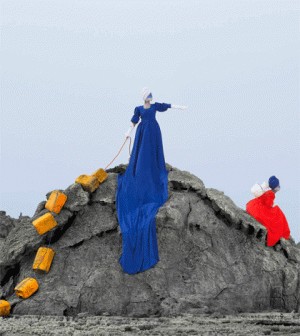- Finding Unshakable Power in a World That Wants to Pull Us ApartPosted 5 months ago
- What could a Donald Trump presidency mean for abortion rights?Posted 5 months ago
- Financial Empowerment: The Game-Changer for Women in Relationships and BeyondPosted 6 months ago
- Mental Health and Wellbeing Tips During and After PregnancyPosted 7 months ago
- Fall Renewal: Step outside your Comfort Zone & Experience Vibrant ChangePosted 7 months ago
- Women Entrepreneurs Need Support SystemsPosted 7 months ago
INTERVIEW-Ethiopian photographer spotlights impact of water scarcity on women

By Nita Bhalla | Thomson Reuters Foundation
In Ethiopia, almost four in 10 people do not have access to clean water and a child dies every hour of diseases caused by the shortages
NAIROBI, Sept 24 – A collection of striking photographs set in the arid landscapes of northern Ethiopia aims to spotlight the harsh reality of water scarcity and how it impacts the lives of women across Africa, said artist Aida Muluneh.
Muluneh’s “Water Life” series – depicting turbaned, painted women in robes of primary colours of blue, yellow and red, posing in the desert – went on show in London on Tuesday, commissioned by the charity WaterAid.
“When WaterAid approached me, I felt that this was something I needed to engage in because water is a big issue in my country, and also the regions that I work in,” Muluneh, an Ethiopian national, told the Thomson Reuters Foundation.
“My work has always focused on the important role of women in society and I have had many conversations with women about the hardships they endure – and access to clean water is one of the biggest challenges they face.”
Globally, one in 10 people do not have access to clean water, according to WaterAid. In Ethiopia, the figure is almost four in 10 and a child dies every hour of diseases caused by the shortages.
As well as harming people’s health, Muluneh said, the shortages have a devastating impact on the lives of women and girls who have to trek long distances to fetch water, making them vulnerable to sexual violence.
Some have to miss school during their periods due to a lack of running water, she said.
Muluneh describes her style as “Afrofuturistic” – a movement that seeks to challenge stereotypical views of the continent and its people – in this case by portraying traditional African ornamentation and body paint in a more futuristic manner. “Through art and creativity, we can also advocate by working on projects such as ‘Water Life’ which address societal issues, but do not perpetuate negative stereotypes of the continent,” she said.
“We’re bombarded with images of suffering and strife from Africa. So for me, it was just about using a different way to engage an audience in issue of water scarcity and the strength of the women that deal with this issue daily.”
Muluneh said working on the project, which involved four days of shooting in Afar’s Dallol region – one of the hottest and driest places on earth – had been an exhausting, yet rewarding experience.
“The landscapes – deserts and volcanic mountains – are greatly inspirational, and are a photographer’s dream. But the conditions are not exactly comfortable. It’s really hot,” she said.
“But to me, if we’re talking about issues of water, I wanted to go to a place that was quite dry and also meet with communities there because the resilience of these communities who live in these conditions is quite amazing.”
The exhibition, which is also supported by the H&M Foundation, will be on display at Somerset House in London until Oct. 20.
(Reporting by Nita Bhalla @nitabhalla, Editing by Claire Cozens. Please credit the Thomson Reuters Foundation, the charitable arm of Thomson Reuters, that covers humanitarian news, women’s and LGBT+ rights, human trafficking, property rights and climate change. Visit http://news.trust.org. Feature slider photo courtesy of Aida Muluneh/WaterAid)
Our Standards: The Thomson Reuters Trust Principles.






